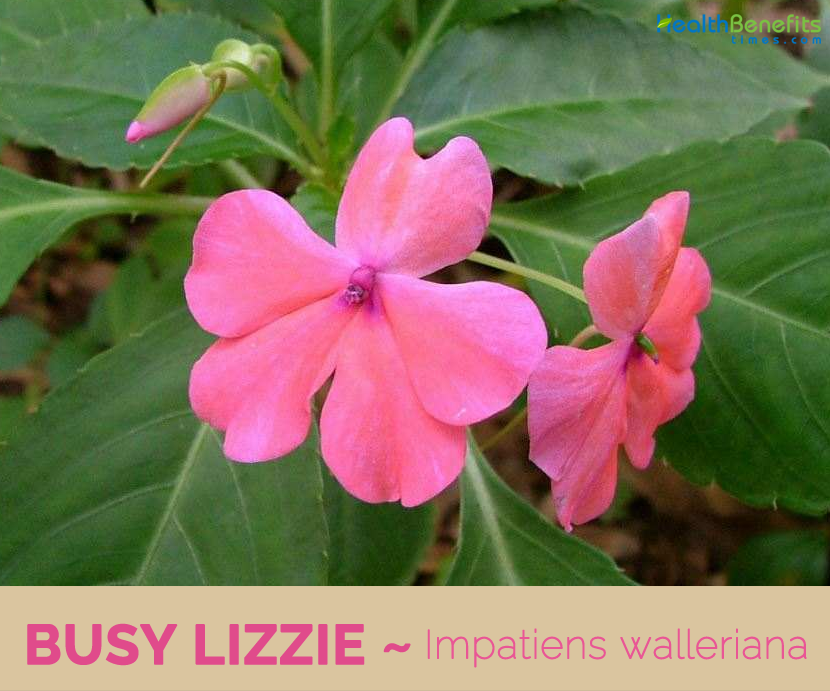| Busy Lizzie Quick Facts | |
|---|---|
| Name: | Busy Lizzie |
| Scientific Name: | Impatiens walleriana |
| Origin | East Africa (i.e. southeastern Kenya, Tanzania, southern Malawi, western Mozambique and eastern Zimbabwe) |
| Colors | Pale greenish |
| Shapes | Smooth capsule, 15-20 mm long and 4-6 mm wide, swollen in the middle |
| Taste | Bitter |
| Health benefits | Beneficial for bee stings, insect bites, and stinging nettle rashes, irritations of the gastro-intestinal canal, alleviate inflammation caused by allergies |
Plant Description
Busy Lizzie is a flowering perennial or annual herb, simple or branched with succulent, translucent, green or reddish tinged, glabrous stem, slightly thickened and semi-woody at the base. The plant grows about 30–90 cm high and is found growing in coastal forest areas, riverine thickets, river margins, bush land, waterway margins, damp and shady places, humid places, and in riparian habitats, also cultivated in gardens and greenhouses; It has become a weed of roadsides, disturbed sites and waste areas in populated areas. The plant prefers slightly acid to neutral, moist, well drained good garden loam rich in organic matter such as leaf mold or compost with liberal amounts of coarse sand for good drainage. All parts of the plant (leaves, stems, flowers, roots) are soft and easily damaged.
Leaves
The leaves are mostly alternately arranged, but the uppermost ones can sometimes be oppositely arranged. They are about 13 cm long and 2.5– 5.5 cm wide, with 5–8 pairs of lateral veins. They are oval (i.e. elliptic) or egg-shaped in outline (i.e. ovate) and borne on stalks (i.e. petioles) 1-4 cm long. The leaf blades are glossy with margins ranging from almost entire to slightly toothed (i.e. crenate or denticulate). They are hairless (i.e. glabrous) with pointed tips (i.e. acuminate apices).
Flower & Fruits
The flowers appear predominantly in pairs or threes at the leaf-stem junction in the top part of the plant. The flowers come in a wide variety of colors (i.e. pink, red, orange, white, purple, etc.), but pink is most common in naturalized plants. These flowers are usually arranged in small clusters of two or three in the upper leaf forks, with each flower being borne on a stalk (i.e. pedicel) 1-3 cm long. They have five showy petals (10-20 mm long) and three sepals. One of the sepals is relatively large (about 10 mm long) with a characteristic whitish spur (20-32 mm long), while the other two are tiny and easily missed. The uppermost petal is usually slightly larger than the others with a keel on its underside. Flowering occurs throughout the year. The fruit is a smooth greenish capsule 15-20 mm long and 4-6 mm wide and fleshy when young. These fruit are swollen in the middle and have a ribbed surface. Ripe fruits explode with even slight push and eject small brownish seeds.
Traditional uses and benefits of Busy Lizzie
- Leaves and roots dried, pounded mixed with water, juice drank as abortifacient.
- North American impatiens has been used as herbal remedies for the treatment of bee stings, insect bites, and stinging nettle (Urtica dioica) rashes.
- They are also used after poison ivy (Toxicodendron radicans) contact to prevent a rash from developing.
- Rich in mucilage, it forms a soothing and demulcent jelly that is used in the treatment of irritations of the gastro-intestinal canal.
- This essence of the remedy addresses mental stresses and tensions.
- It calms feelings of impatience and irritability.
- Potawatomi and tribes of the Appalachian area used the impatiens to prevent any form of allergic reaction, athlete’s foot, and dandruff.
- Impatiens is rubbed on the skin to alleviate inflammation caused by allergies.
- Some people suggest taking the plant as a tea or as a garnish in salad.
Culinary uses
- Flowers are edible and have a sweet taste.
- They can be added to salads or mixed into fancy drinks.
- Plant is a source of ’salep’, a fine white to yellowish-white powder that is obtained by drying the tuber and grinding it into a powder.
- Salep is a starch-like substance with a sweetish taste and a faint somewhat unpleasant smell. It is said to be very nutritious and is made into a drink or can be added to cereals and used in making bread etc.
- One ounce of salep is said to be enough to sustain a person for a day.
Other Facts
- It is widely cultivated as an ornamental in masses in shady beds, borders and woodland gardens, as ground cover or edging along walks or paths in parks and gardens.
- It is also cultivated in containers, window boxes and hanging baskets as a house plant.
- All parts of the plant (leaves, stems, flowers, roots) are soft and easily damaged.
- During the course of its life, the impatiens undergoes a sex change! When the flower first opens, it is male; when the pollen shell sheds, the flower becomes female!
- Some varieties of impatiens can be used as a dye for Henna and hair coloring.
- In ancient China, impatiens petals were mixed with roses, orchids and alum to make nail polish.
- In south-eastern Queensland, it is ranked among the top 200 most invasive plant species.
Precautions
- All Impatiens taste bitter and seem to be slightly toxic upon ingestion, causing intestinal ailments like vomiting and diarrhea.
References:
https://www.itis.gov/servlet/SingleRpt/SingleRpt?search_topic=TSN&search_value=503160#null
https://davesgarden.com/guides/pf/go/2301/
http://www.hear.org/pier/species/impatiens_walleriana.htm
https://npgsweb.ars-grin.gov/gringlobal/taxonomydetail.aspx?id=19862
https://www.cabi.org/isc/datasheet/28769
http://www.missouribotanicalgarden.org/PlantFinder/PlantFinderDetails.aspx?kempercode=a586
http://www.theplantlist.org/tpl1.1/record/kew-2863395
https://en.wikipedia.org/wiki/Impatiens
https://en.wikipedia.org/wiki/Impatiens_walleriana
Comments
comments
